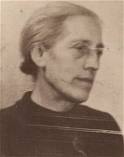After reading an article about an evader’s wartime story in a national newspaper a Dutch lady, living in England responded by ringing the newspaper, and asking for the name and address of the writer. The lady had a very interesting story to tell, and forwarded the information below to the evader, a member of ELMS.
Murder at 49 Diepenstraat, Tilboug – a helper’s story from Holland
Vicky Godfrey
Many pilots were hidden in the house of a widow near my home. My father used to collect money to help feed them and acted as a courier for them in Holland. I used to collect English books for the airmen to read. My father went often to the widow’s house to speak with the pilots. I had collected many paperback books for them to read and when my father came back one day he brought me two pennies that the pilots had given to him for me, a small token for my efforts. I hung the pennies on the wall of my bedroom where they stayed until my father died in 1968, when they were then put carefully away. After my father left the widow’s house one day, that same day the Gestapo did a house search, and the widow was taken away; the three pilots offered resistance, and were shot. The widow never talked, was horribly tortured and I do not really know if she was executed. The two pennies meant a lot to my family, and to me in particular. I have never met the families of the aircrew who were murdered.
The two pennies are on display in the Escape Line Hut, Hut 9, at Eden Camp Museum, together with their story.
_____________________
On learning of that story the interest of ELMS members was immediately aroused. Through relatives of Mrs Vicky Godfrey in Holland, our Helper Representative Elizabeth Harrison, research through records and assistance from the RAF, the following story unfolded:
On the night of 16/17 June 1944, Halifax NA514 based with 431 (RCAF) Squadron RAF at Croft, North Yorkshire, was downed by a night-fighter near Nistelrode in Holland. Only the navigator FO Roy Carter managed to evade the Germans. The rest of the crew died or were captured. Carter buried his chute, contacted a local Dutch farmer and was given food and shelter. His journey along the Dutch escape line had begun.
On Sunday 9th July, the SD (Dutch), accompanied by the Gestapo raided the house of Coba Pulskens in Diepenstraat. The 61 year old widow ran a safe-house where evaders had to enter through her grocers shop. At the time that the Gestapo broke down Coba’s door, Sgt Roy Carter and two other aircrew evaders were eating breakfast around a table. It is understood that the aircrew offered resistance and were taken outside and executed against the garden wall, despite the fact that they were unarmed. Coba Pulskens was ordered by the Gestapo to get a sheet or cloth to cover the bodies. In defiance, Coba went upstairs and, from a hiding place, recovered a new large Dutch flag (banned by the Germans) and covered all three evaders with it. This infuriated the Germans. She was then taken away by the Gestapo and harshly interrogated. She gave no one away. After a long period of brutal interrogation Coba was eventually sent to Ravensbruck concentration camp.
The bodies of the three airmen were taken from the house to a nearby hospital (where an alert doctor took photographs of them), then taken to the concentration camp at Vught, near South Hertogenbosch were they were quickly cremated. Because the bodies of the airmen were not found they are listed as ‘missing in action’ by the RAF.
A plaque in memory of Coba Pulskens and the three airmen was erected at her house, 49 Diepenstraat, in Tilbourg in 1947. On 27 October 1994 a large granite monument was unveiled on Coba Pulskenslaan in Tilbourg, to honour Coba and the three airmen, heroes to the Dutch in those terrible years of occupation. The SD (Dutch Nazi), and Gestapo men who carried out the arrest and executions on July 9th 1944, were eventually tracked down and tried by a British Military Court. On evidence from the Dutch Resistance and Coba’s family, together with the photographs taken by Dr Borman of St Elizabeth’s Hospital in Tilbourg, four of the ten Nazis were hanged.
According to survivors of Ravensbruck, Coba continued her acts of defiance and courage while in the camp. One day she voluntarily stepped forward to take the place of a young mother and her children who had been sentenced to death. She apparently said, “If someone has to give their life, I hope to do it. I can better be missed than others and the children”. Coba died in the gas chamber of Ravensbruck in May 1945 – ironically, the war was over!
The Dutch flag, which was used by Jacoba Pulskens to cover the bodies of the airmen, was tracked down and brought to England. It was dedicated in the Airmen’s Chapel in the Church of St Michael, Coningsby, England, on the 8th May 1983, near RAF Coningsby.
The Inscription in the church reads:
The Flag of the Netherlands hangs here to honour the memory of Jacoba Maria Pulskens of Tilbourg – Holland, who was a member of the Resistance Movement during the enemy occupation of her country In World War 2, her house being used by allied airmen in the escape network.
In July 1944, whilst housing three Allied airmen, Flt Lt RA Walker DFC 83 Squadron RAF, F/O RE Carter 431 (RCAF) Squadron RAF, and FO JS Knott (RAAF) 77 Squadron RAF, Coba and the aircrew were all captured by the enemy. The three airmen were shot. Before being taken away herself, never to return, Coba Pulskens covered the bodies with the flag, that now hangs in this chapel as a tribute to her bravery and the airmen she sought to protect.

